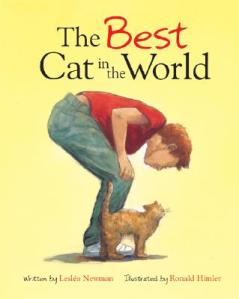 The Best Cat in the World
The Best Cat in the World
Leslea Newman, ill. Ronald Himler
Newman, L. 2004. The best cat in the world. Grand Rapids, MI: Eerdmans Books for Young Readers.
Summary:
A young boy named Victor loses his older cat Charlie, who was the best cat in the world. Nothing seems to make Victor feel better, not the pictures he draws, not even talking to the rosebush where Charlie was buried. When the vet calls their family with an emergency, a kitten who needs a new home, Victor is not sure that she will be able to fill the paw prints of Charlie in their family. She’s definitely different than Charlie, and doesn’t do the same things that Charlie used to do, but as his mom reminds him, the new kitten is not Charlie. Slowly, Victor starts to realize that even though she’s not Charlie, she’s still going to be a great cat, and maybe more than one cat can be “the best cat in the world.”
Quantitative Summary
ATOS Book Level: 3.6
Interest Level: Lower Grades K-3
Lexile: 780L
Qualitative Summary
This book is densely written, with most pages having a lot of text. The narrative is straightforward and discusses a singular narrator’s feelings; it is written with a good sense of emotion for a young age level. The knowledge demands seem Middle Low, there is a singular but somewhat complex theme (coping with death). The message of the story may hit home to some children and help them with their feelings. Personally, I cried through the whole thing, so I commend anyone who might be able to read it out loud to students. The watercolor illustrations are beautiful, and focus on the emotions of the boy.
Curriculum Tie Ins
Could be useful in a class or guidance counselor session with a student who has lost a pet.
Standards
MD CCSS – Reading/Comprehension Grade 3
Standard 3.0 Comprehension of Literary Text
TOPIC A.
INDICATOR
- Develop comprehension skills by reading a variety of self-selected and assigned literary texts including print and non-print
OBJECTIVES
- Listen to critically, read, and discuss a variety of literary texts representing diverse cultures, perspectives, ethnicities, and time periods
- Listen to critically, read, and discuss a variety of different types of fiction and nonfiction texts
INDICATOR
3. Use elements of narrative texts to facilitate understanding
OBJECTIVES
a. Identify and distinguish among types of narrative texts such as characteristics of the general categories of fiction versus nonfiction, realistic fiction, tall tales, legends, fables, fairy tales, biographies
Assessment limits:
Grade-appropriate narrative texts
b. Identify and explain the elements of a story
Assessment limits:
Main problem, sequence or chronology of events, and solution to the problem
c. Identify and describe the setting and the mood
Assessment limits:
- Details that create the setting
- Details that create the mood
d. Identify and analyze the characters
Assessment limits:
- Character’s traits based on what character says, does, and thinks and what other characters or the narrator says
- Character’s motivations
- Character’s personal growth and development
Other relevant info:
Author website: http://www.lesleanewman.com
Illustrator website: http://www.ronhimler.com/
